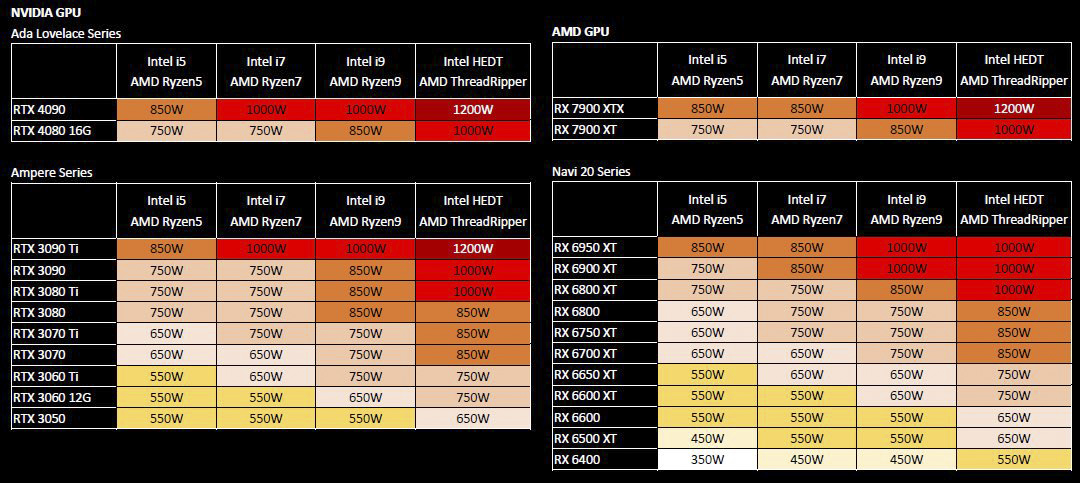Asus Lists Identical PSU Requirements for RX 7900 XTX as RTX 4090
Asus has released a newly-updated power supply wattage recommendation spreadsheet for the RX7900 and the RX 7900 XTX , according to a Tweet from @momomo_us. Asus recommends the same power supply wattage for the upcoming Radeon RX 7900 XTX as the Nvidia RTX 4090 — currently, the best graphics card — suggesting AMD's counterpart might see higher power draw in third-party overclocked cards.
AMD recently announced its brand new RX 7000 series of GPUs, which use the AMD RDNA3 GPU architecture, starting with the RX 7900 XT and RX 7900 XTX. One of the most prominent features of the 7900 XTX announcement was its power efficiency, with the 7900 XTX rated for 355W — 95W lower than the 450W RTX 4090. Performance comparisons between the RX 7900 XTX and RTX 4090 were not shown, but the RX 7900 XTX could come close to the RTX 4090, particularly in non-ray tracing games.
However, the RX 7900 XTX's power specifications only apply to the reference model. We fully expect to see factory overclocked AIB partner models with higher power targets once the cards launch. What we don't know is how high these power targets will go, but Asus at least appears ready to push up to 450W.

Asus is recommending anywhere between 850W to 1200W for the RX 7900 XTX, depending on your processor. For users running an Intel Core i5 or Core i7, or an AMD Ryzen 5 or Ryzen 7, Asus recommends 850W. For users running a Core i9 or a Ryzen 9, Asus recommends 1000W. Finally, for users running HEDT platforms such as Intel X299 or AMD Threadripper, Asus recommends at least 1200W. These power supply recommendations are the exact same as the RTX 4090.
This suggests Asus's aftermarket versions of the RX 7900 XTX could ship with the same power targets as some of its RTX 4090 cards, which run anywhere from 450W to 480W, depending on the model (and hitting as high as 600W when manually overclocked).
Perhaps just as important, this also suggests the upcoming RX 7900 XTX and XT cards could have a decent amount of overclocking headroom. AMD said in its RDNA 3 architecture deep dive that it was "designed to reach 3 GHz," but the reference clocks announced so far are only 2.5 GHz. There were hints that overclocking could go quite a bit higher, at the cost of efficiency, so tacking on an additional 100W (or more?) of power might just get AMD's GPUs past the 3 GHz mark — something we also saw with the RTX 4080 when overclocked.
But Asus could also just be copy-pasting its PSU recommendations to keep things "simple." Asus doesn't specify which model or generation of Intel/AMD processors it's referring to, which makes the power supply spreadsheet less useful as different generations have different power ratings.
The Radeon RX 7900 XTX and XT cards are set to launch on December 13. We're certainly curious to see how the cards perform, and whether there's some overclocking headroom waiting for adventurous users. We should know next month if Asus's PSU requirements are legitimate.
Get Tom's Hardware's best news and in-depth reviews, straight to your inbox.

Aaron Klotz is a contributing writer for Tom’s Hardware, covering news related to computer hardware such as CPUs, and graphics cards.
-
Makaveli They also don't state the Quality of PSU.Reply
A 850 watt Silver PSU will not be the same as a 850 watt Titanium model. -
BillyBuerger ReplyMakaveli said:They also don't state the Quality of PSU.
A 850 watt Silver PSU will not be the same as a 850 watt Titanium model.
The 80plus rating is not directly related to quality of the PSU. An 80plus (base) PSU and a 80 plus titanium PSU rated for the same wattage should be able to delivery the same wattage. The Titanium will produce less heat doing that but assuming they are build well, the results of the power delivery should be the same. The Gigabyte PSU Newegg was dropping on people to buy a GPU was a gold rated PSU but that means nothing if it explodes due to bad quality. -
RodroX I hope other AIBs go out with both, "normal" (close to reference clocks) and OC models, so people can choose what they want/like/prefer.Reply
Not everyone want, or need an OC model. -
Fates_Demise ReplyMakaveli said:They also don't state the Quality of PSU.
A 850 watt Silver PSU will not be the same as a 850 watt Titanium model.
Actually they are, ratings are for output not input. BOTH will output 850 watts, 1 will draw less than the other from the wall. -
Warrior24_7 All of that garbage spewed about power consumption by AMD fanboys, this is what you get?!! A power hungry GPU that less powerful! The more you hear this GPU the worst it gets! AMD lied to their fanboys! There is NO WAY I’d buy this thing! Let the hypocrisy begin. Waahahahahaha!Reply